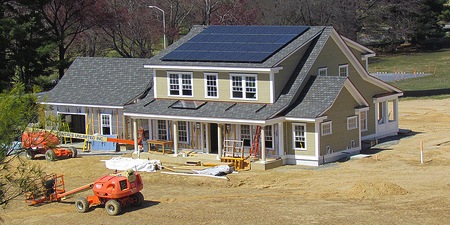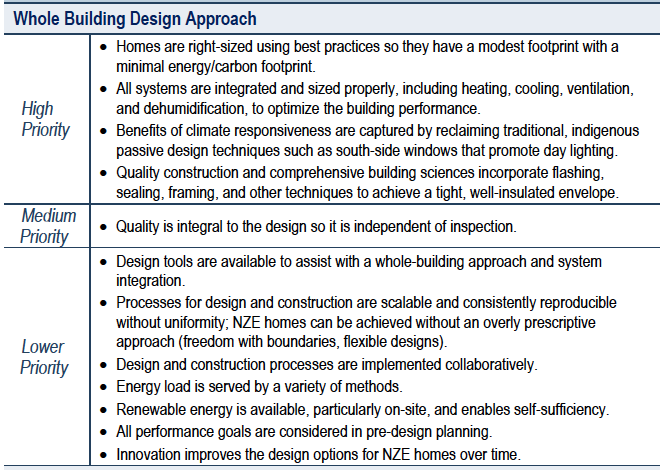NIST Takes on the Net Zero Energy Home Challenge

When you think of the National Institute of Standards and Technology (NIST), do you think of atomic clocks and hunks of metal that serve as standards of mass and length? Or do you think of cutting edge research in net zero energy (NZE) homes? It turns out, they do indeed still deal with standards, but they also do a lot of great research, including studying NZE homes.
When you think of the National Institute of Standards and Technology (NIST), do you think of atomic clocks and hunks of metal that serve as standards of mass and length? Or do you think of cutting edge research in net zero energy (NZE) homes? It turns out, they do indeed still deal with standards, but they also do a lot of great research, including studying NZE homes.
The photo above is their recently completed Net-Zero Energy Residential Test Facility (NZERTF), which is pretty darn cool. For its first year, it’s going to be operated just as if a family of four were living in it so they can monitor just about every detail of its performance and get a lot of almost-real world data about NZE homes. Here’s a nice video about it:
Developing guidelines for NZE homes
In addition to their NZE research, NIST has also been hosting meetings of experts over the past few years to help gather what we know and figure out what we need to know yet about NZE buildings. Their most recent one was Strategies to Achieve Net-Zero Energy Homes, and they just released the report on it last month. It’s called Strategies to Achieve Net-Zero Energy Homes: A Framework for Future Guidelines Workshop Summary Report (pdf), and you can download it by clicking the linked title.
As they say in the introduction, the purpose isn’t to tell you how to do it but rather “to aid in developing a set of future guidelines for the residential building community and homeowners as they design, construct, and operate NZE homes.” Some of the folks who were at this meeting are Sam Rashkin, formerly with ENERGY STAR new homes program at EPA, now at US DOE, Dave Karmol of the International Code Council, Asa Foss with the US Green Building Council, and Wes Davis of the Air Conditioning Contractors of America.
The document reviews where we’re at with regard to understanding how to do net zero homes properly. The three main categories they focused their efforts on are:
- Design Challenges and Tools
- Technology and Equpment
- Homeowner and Building Industry Needs and Behavior
Within each category, they identified the big issues and then prioritized them as high, medium, or low, as shown in the section on whole building design:

The report also gives “challenges and barriers” and “potential guidance elements” for each of the three main sections above and goes into some detail about the items discussed by the group.
Where is RESNET’s Home Energy Rating System?
 One thing puzzled me about the report, though. On report page 9 (pdf page 19), they write, “A scoring system is needed for homes to enable consumers to compare energy, durability, indoor air quality, accessibility, and other factors relative to their needs during the purchase of newly constructed and existing homes.”
One thing puzzled me about the report, though. On report page 9 (pdf page 19), they write, “A scoring system is needed for homes to enable consumers to compare energy, durability, indoor air quality, accessibility, and other factors relative to their needs during the purchase of newly constructed and existing homes.”
I agree, and I believe that RESNET’s Home Energy Rating System (HERS) has already made a good start toward this end with the HERS Index. I can certainly understand that a HERS rating currently doesn’t do everything they want, since they’re looking for much more than just energy performance. Not once on that page, however, do the authors even acknowledge that a HERS rating already does the biggest chunk – the energy performance.
They don’t even list RESNET in the “Existing Resources” section. How can the Carpet Research Institute merit inclusion here but not RESNET? That’s a bit baffling to me.
Let’s get going with net zero energy homes
Overall, this report is a good start at identifying the issues we need to work on. NZE homes, I think, have the potential to be more appealing than other green building or energy efficiency programs because it’s not just giving homeowners a feel-good label. In fact, there’s no official label at all right now (although the HERS Index comes closest).
Net zero energy gives homeowners a goal and can help shape their behavior. Buying an ENERGY STAR home is a good thing, especially with version 3 of the program, but homeowners could move in and think they’ve already arrived. With net zero, it’s as much about how they live in the house as how the house was designed and built. They can watch their energy consumption and modify what they do so they can actually achieve net zero. Ask Amy Musser and Matt Vande or Steve Larson. They’ll tell you how important monitoring and adjusting is when you want net zero performance in a net zero home.
The NIST folks still need to get a bit more realistic, though. In addition to ignoring RESNET, they also gave a medium priority to this: “Triple-pane windows with ratings of R-7 and above will be employed.” Really? In every climate? No matter how low the cost of photovoltaic modules goes?
Still, this report is a valuable contribution that can help further the NZE cause. The bulk of the report is really good and should lead to a good set of guidelines for net zero energy homes, something that’s sorely lacking.
Download the NIST Report (pdf)
Related Articles
A Really Cool Net Zero Energy Home in the North Carolina Mountains
A 20 Year Old Energy Efficient House Goes to Net Zero in Florida
A Net Zero Energy Home in Rural Tennessee
Photo by National Institute of Standards and Technology from flickr.com, used under a Creative Commons license.
This Post Has 2 Comments
Comments are closed.

I agree, it is odd that
I agree, it is odd that RESNET and the HERS Index rating were not mentioned in this.
It’s hard to reach zero with
It’s hard to reach zero with a standard that shows EE improvements as a percentage improvement (HERS) against a moving target (2003 and then 2006 IECC). We need to look at actual energy consumption:http://www.earthadvantage.org/programs/energy-efficiency/energy-performance-score/about-eps/ if we really want to take NZ seriously. I’d also like to put a plug in for Earth Advantage’s Net Zero / Net Zero Ready certification program: http://www.earthadvantage.org/programs/homes/earth-advantage-zero/ because I think our guidelines are a lot more straight forward than this 51 page pdf.